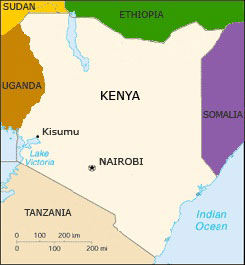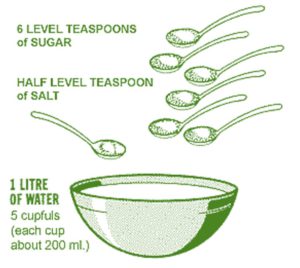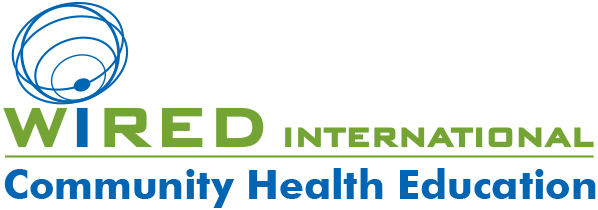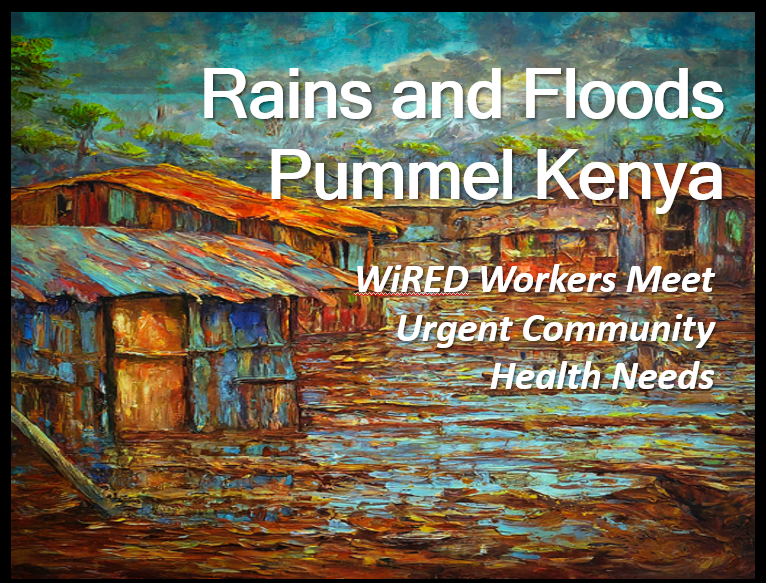By Allison Kozicharow; Edited by Elizabeth Fine
 Torrential rain and flooding are now creating calamitous conditions in Kisumu, Kenya, where WiRED International’s paraprofessional team of community health workers (CHWs) live and guard the health of their communities.
Torrential rain and flooding are now creating calamitous conditions in Kisumu, Kenya, where WiRED International’s paraprofessional team of community health workers (CHWs) live and guard the health of their communities.
Sister Bernadette Nealon, who oversees WiRED’s CHW program in Kisumu, sent this report:
The rain and the floods are unbelievable. To watch what is happening on television is heartrending, people trying to escape the floods as their homes are made into what I can describe as mounds of mud. People who jumped into the back of lorries or even those who were passengers trying to reach their destination were swept away and the vehicles became just mangled tin as they too were washed away by floods.
![]() The current El Niño event is only making matters worse as climate change hastens extreme weather in Kenya. In addition to the relentless rain, civil unrest and starvation continue to plague people in Kenya and the whole Horn of Africa, where disruption of the food chain has been impacted by the war in Ukraine. The final insult is the year-round seesaw between torrential rain and drought.
The current El Niño event is only making matters worse as climate change hastens extreme weather in Kenya. In addition to the relentless rain, civil unrest and starvation continue to plague people in Kenya and the whole Horn of Africa, where disruption of the food chain has been impacted by the war in Ukraine. The final insult is the year-round seesaw between torrential rain and drought.
Lillian Dajoh manages the day-to-day work of WiRED CHWs. She described the flooding in this statement:
![]() It is true that the floods are devastating. Most rivers, dams and lakes have broken their banks causing more havoc. School openings have been postponed because affected people have moved to seek safety. Some of the schools are flooded and very dangerous to students.
It is true that the floods are devastating. Most rivers, dams and lakes have broken their banks causing more havoc. School openings have been postponed because affected people have moved to seek safety. Some of the schools are flooded and very dangerous to students.
What is the WiRED CHW team doing to protect their communities during this challenging time? They are preparing people for the inevitable onset of water-borne diseases that flooding promotes — cholera, malaria and dysentery. The CHWs teach people how to avoid these diseases and how to treat them if necessary. Critically, the CHWs also teach people how to treat contaminated water so that it can be used for drinking and washing (see sidebar). Prevention and good health practices are the hallmark of CHW training and practice.
 WiRED is staying in close touch with our team in Kisumu and will post stories as the CHWs take action to preserve people’s health in this flood emergency.
WiRED is staying in close touch with our team in Kisumu and will post stories as the CHWs take action to preserve people’s health in this flood emergency.
DISINFECTING WATER
WiRED’s CHWs will share with people in their communities descriptions of two techniques critical to prevent deadly diseases when water is contaminated. While these measures are needed today in Kenya, everyone reading this article might want to know about them, should floods hit their community someday.
The Centers for Disease Prevention and Control (CDC) offers these two methods for emergency water disinfection. Follow the link for details. NOTE: These techniques address water that is contaminated with bacteria, viruses or parasites. These techniques will NOT address water contaminated with chemicals.
Boil the water
If you don’t have safe bottled water, you should boil your water to make it safe to drink. Boiling is the surest method to kill disease-causing germs, including viruses, bacteria and parasites.
You can improve the flat taste of boiled water by
- pouring it from one container to another and then allowing it to stand for a few hours, OR
- adding a pinch of salt for each quart or liter of boiled water.
Use bleach
Making water safe to use with bleach having a 5% to 9% concentration of sodium hypochlorite (most common in the U.S.) If the water is cloudy, murky, colored or very cold, add double the amount of bleach listed here
1 quart/liter water
If you have a dropper:
Add 2 drops of bleach
If using milliliters (mL):
Add 0.1 mL of bleach
If using measuring spoon:
Add a tiny amount (too small to measure)
Source: CDC
ORAL REHYDRATION THERAPY
Water-borne diseases often dehydrate the human body, and dehydration can kill people and especially children. To rehydrate someone — to get water into their systems — you will need more than plain water. The best approach is to use Oral Rehydration Therapy (ORT). ORT packets are available to mix with water to give to the person who is ill.
However, these packets may not be available; in which case, you can make your own Oral Rehydration solution (ORS) from sugar and table salt that most homes have on the kitchen table. YOU MUST USE THE CORRECT PROPORTIONS OF SUGAR, SALT AND WATER. Here’s how:
This discussion is adapted from the Rehydration Project
https://rehydrate.org/faq/how-to-prepare-ors.htm
If ORS packets are not available, mix an oral rehydration solution:
Recipe for Making a 1 liter ORS solution using sugar, salt and water
- Clean water – 1 liter – 5 cupsful (each cup about 200 ml.)
- Sugar – Six level teaspoons
- Salt – Half level teaspoon
- Stir the mixture till the sugar dissolves
Drink sips of the ORS (or give the ORS solution to the conscious dehydrated person) every 5 minutes until urination becomes normal.

Adults and large children should drink at least 3 quarts or liters of ORS a day until they are well. If you are vomiting, continue to try to drink the ORS. Your body will retain some of the fluids and salts you need even though you are vomiting.
Remember to take sips of liquids slowly.
Chilling the ORS may help. If you have diarrhea, continue to drink the ORS. The fluids will not increase the diarrhea.
Someone with symptoms of severe dehydration needs to go to an emergency room or other healthcare facility to get intravenous fluids (fluids given directly into the veins through a needle) if possible.
Whatever is causing the diarrhea, vomiting or other symptoms should also be treated.


